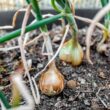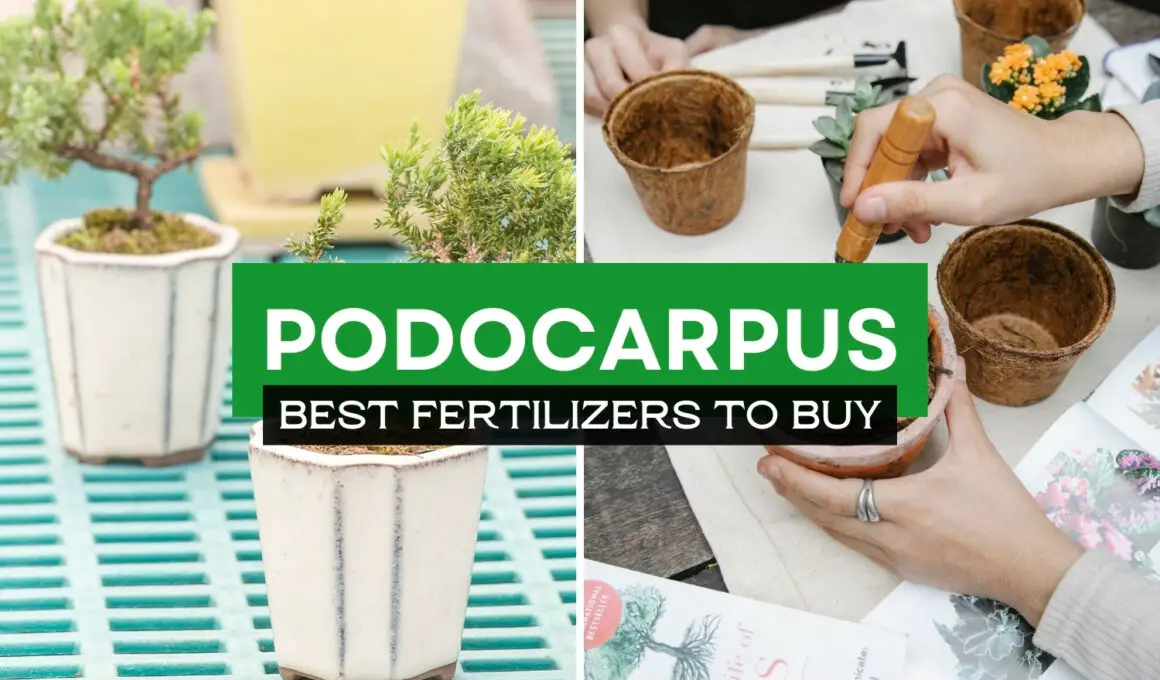In This Article Show
Podocarpus is one of the many lovely shrubs that has caught the eyes of gardeners in recent years. The reason for this isn’t far-fetched; the shrub comes with its lush foliage and elegant form. They are making it perfect for landscaping and gardening.
The perfect fertilizer for podocarpus is a slow-release fertilizer, especially for trees or shrubs. The recommended NPK ratio for podocarpus is 10-10-10 or 20-20-20. The following list of fertilizers comes in this ratio.
| Image | Product | Features | Price |
|---|---|---|---|
Best Overall  | 9.9 | Check Price | |
 | 9.8 | Check Price | |
 | 9.7 | Check Price | |
 | BioAdvanced Shrub Care Protect & Feed Get Gardening For Beginners Our new EBOOK shows newcomers and green thumbs alike a step by step guide to growing the garden of their dreams. | 9.6 | Check Price |
 | 9.5 | Check Price | |
 | 9.5 | Check Price |
Members of the podocarpus genus come in different varieties, which affects their sizes and shapes. You may find podocarpus to be a small shrub and another to be a tall tree, however, you’d mostly find them large.
Podocarpus requires some feeding of fertilizers, although you do not have to give them so much. You may have to feed them during spring, to help new growth and also through the growing season, however, this depends on what type of soil you’re using.
Growing podocarpus is one thing; however, ensuring it stays healthy is another. A major way to keep your plants healthy is by giving them the right fertilizer that will help them grow.
Understanding the Nutrient Needs of Podocarpus
Podocarpus, also known as yew pines or Buddhist pines, are evergreen trees native to the Southern Hemisphere. They are loved for their low-maintenance nature and hardy disposition, but just like any other plant, they have their specific nutrient needs to flourish and grow optimally.
The main nutrients that any plant, including Podocarpus, needs are Nitrogen (N), Phosphorus (P), and Potassium (K). But, Podocarpus has its unique preferences.
Get Gardening For Beginners
Our new EBOOK shows newcomers and green thumbs alike a step by step guide to growing the garden of their dreams.
Firstly, Nitrogen plays a crucial role in the growth of Podocarpus, promoting lush, green foliage. It aids in developing chlorophyll, the compound that plants use to convert sunlight into food, a process known as photosynthesis.
Phosphorus, on the other hand, helps with the development of roots and flowers. It’s especially needed during the early growth stages and when the plant is setting buds. While Podocarpus is not particularly known for its flowers, it does produce inconspicuous flowers that eventually develop into attractive berries. Therefore, adequate phosphorus is needed.
Potassium works to promote overall plant health. It helps with water regulation within the plant and plays a role in the production of proteins and sugars. This nutrient is essential for helping the Podocarpus withstand stresses, such as drought, cold, and disease.
In addition to N-P-K, Podocarpus also needs micronutrients, like iron and magnesium. These elements are needed in smaller quantities but are essential for the overall health and well-being of the plant.
Lastly, but certainly not least, is the soil’s pH level. Podocarpus prefers slightly acidic to neutral soil. A pH of 5.5 to 7.0 is ideal for this type of plant. If the soil is too alkaline, Podocarpus may struggle to absorb the nutrients it needs, even if they are present in the soil.

The Best Fertilizers for Podocarpus
Finding fertilizer for your podocarpus can be a little stressful since many fertilizers are out there, and it’s hard to choose without a guide. We thought to make the work easy for you! Here are the six best fertilizers for your podocarpus.
The Miracle-Gro Shake ‘N Feed is one of the best products you can find out there for feeding shrubs and trees. We love that it is formulated with organic ingredients such as feather meal, earthworms, kelps, and bone meal, all of, which will nourish the soil and the plant. It is also made in proportions that ensure the plants get the best nutrients.
We love that this fertilizer is beneficial for microbial growth in the soil, thereby making the soil healthy enough to nourish the root of the plant. It also slowly releases the nutrient, ensuring that the plant gets its nutrient for a long period.
We love that you can also use Miracle-Gro through all the seasons, it is a water-soluble fertilizer and will deliver your result quickly. To apply, Mix this fertilizer with some water and spray on your plant, you may not see the result you need if you do not apply the water-soluble fertilizer directly.
Scotts’ continuous-release plant food is just what you need for your podocarpus! This fertilizer contains essential nutrients, in the right proportion that your shrubs and trees need to grow. You’d love this fertilizer, if you intend to see your plant’s foliage bloom and its roots grow.
Scotts’ fertilizer works well for plants such as dogwood, hydrangeas, magnolias, podocarpus, and many other shrubs. We love that this fertilizer was formulated with shrubs and trees, we also love that it contains the important nutrients that your plant needs to grow normally.
Although it comes in granules, it is really easy to use. All you need do is apply the right amount to your shrubs or trees and water them. We recommend that you use it as prescribed by the manufacturers, Not adhering to the manufacturer’s application guidelines can cause burning.
We love the golden tree plant food, and the reason isn’t far-fetched! This fertilizer is a highly concentrated organic plant food that works well to help plants grow.
It is perfect for plants, shrubs, or trees that may be dying due to low nutrient supply, this fertilizer works by nourishing the roots with a high amount of nutrients that help the plant, not only gets its life back but also increase its growth.
It works its magic by providing both additive and fertilizer to the plant, at the same time. We love that Golden Tree concentrated fertilizer works well for podocarpus and different plant types.
Because of this fertilizer’s high amount of nutrients and additives, you will get the result you require in little to no time. You can feed dying plants the golden tree plant food 1 to 3 times a week.
Bio-advanced shrub fertilizer is right if you want to protect your podocarpus from pests and feed them. We love that this fertilizer works in two ways, giving you what you need for less.
This fertilizer works well to protect and nourish your plant and does so for up to 12 months, after one single application.
This means it is a slow-releasing formula which is excellent for the podocarpus plant. Bio-Advanced Shrub care and feed can protect the plant due to its active ingredient – Imidacloprid, which kills pests and protects it. This frees you from the responsibility of applying pesticides to your garden.
The BioAdvanced fertilizer is a great option for you if you have a busy schedule, you only have to apply it once, and your plant benefits from it, all year round. Ensure you apply it according to the manufacturer’s direction, as an overdose can damage your plant.
Oscomote Smart-Release Plant Food is ideal for busy gardeners, It is a slow-release fertilizer that ensures that your plant is nourished for many months.
This fertilizer contains a balanced mix of phosphorus, potassium, and nitrogen; it also has other essential micronutrients that your plants require.
Oscomote is also easy to apply; however, we recommend that you follow the manufacturer’s guidelines concerning its application. Not only can you use this fertilizer for podocarpus, but you can also use it for other plant types as well.
JR Peters is a trusted brand for fertilizers, and this particular product is nothing short of what is expected. This all-purpose fertilizer can be used on any plant type, especially podocarpus. It has an NPK proportion of 20-20-20, a required podocarpus ratio. It also contains other micronutrients that benefit your plant’s overall health and growth.
We love that this fertilizer is a water-soluble plant food, making it super easy to apply to the plant, you can either apply it to the plant’s leaves or roots. We highly recommend following the manufacturer’s guidelines on applying this fertilizer. It is also perfect for both indoor and outdoor plants.
Types of Fertilizers for Podocarpus
Choosing the right fertilizer for your Podocarpus can significantly impact its growth and overall health. In my over 13 years of lawn care experience, I have experimented with various types of fertilizers, and I can affirm that they are not created equal. There are generally two types of fertilizers to consider for your Podocarpus: organic and inorganic fertilizers.
1. Organic Fertilizers
Organic fertilizers are derived from plant or animal waste, or mineral deposits. They include products like compost, bone meal, and manure. These fertilizers are beneficial because they improve the soil structure, provide a range of nutrients, and release nutrients slowly, reducing the risk of over-fertilization.
Organic options such as compost or well-rotted manure for your Podocarpus can work well. They provide nutrients and improve the soil’s ability to hold water and nutrients.
However, they typically don’t have a high concentration of nutrients, so you might need to apply them more frequently or in larger quantities to meet the plant’s nutritional needs.
2. Inorganic Fertilizers
Inorganic fertilizers, also known as synthetic fertilizers, are chemically manufactured. They usually contain higher levels of nutrients and are designed to be readily available for plant uptake. Inorganic fertilizers often have a balanced N-P-K ratio, which is ideal for Podocarpus.
Using an inorganic fertilizer with a balanced N-P-K ratio ensures your Podocarpus gets an even supply of the major nutrients it needs. Many of these fertilizers are also fortified with micronutrients, which is a plus.
However, inorganic fertilizers don’t improve soil structure, can leach into groundwater if over-applied, and can release nutrients too quickly, potentially burning the plant.
What About N-P-K?
When choosing a fertilizer, you’ll often see three numbers on the packaging, like 10-10-10. These numbers represent the ratio of Nitrogen (N), Phosphorus (P), and Potassium (K), respectively.
A balanced N-P-K ratio, such as 10-10-10 or 14-14-14, is generally recommended for Podocarpus.
In conclusion, the choice between organic and inorganic fertilizers depends on your gardening preferences, environmental consciousness, and the specific needs of your Podocarpus. The key is to ensure that whatever type of fertilizer you choose, meets the nutrient needs of your Podocarpus for optimal growth and health.
How and When to Fertilize Podocarpus
Knowing how and when to fertilize your Podocarpus can significantly impact the health and appearance of your plant.
When to Fertilize
The best time to fertilize Podocarpus is during the growing season, which is usually in the spring and summer months. Fertilizing during this period provides the nutrients needed for new growth. Generally, you should avoid fertilizing late in the fall or during winter as the plant goes into a dormant state and won’t efficiently use the added nutrients.
A good rule of thumb is to fertilize your Podocarpus once in early spring, once in late spring, and once in mid-summer. However, this can vary depending on the specific nutrient needs of your plant and the type of fertilizer you’re using.
How to Fertilize
Before fertilizing, it’s advisable to water your plant thoroughly. This helps prepare the plant to absorb the fertilizer more efficiently and can prevent potential root burn that can occur with some inorganic fertilizers.
When applying fertilizer, make sure to distribute it evenly around the base of the plant, extending it out to the drip line, which is the area under the outer edges of the tree where water drips off the leaves. This is because the feeder roots, which take up most of the water and nutrients, often extend to the drip line.
You can then water the plant again to help move the fertilizer into the root zone for easier absorption. Remember to follow the manufacturer’s instructions on the fertilizer packaging to avoid over-fertilizing, which can damage the plant.
Consistency is key when it comes to fertilizing your Podocarpus. Regularly providing it with the right amount of nutrients will result in a healthier, more vibrant plant.
Frequently Asked Questions About Fertilizing Podocarpus
Podocarpus are popular plants thanks to their low-maintenance nature and versatile landscape use. However, questions often arise regarding their proper care and fertilizing. Here are some commonly asked questions about fertilizing Podocarpus:
Can I use a general-purpose fertilizer for my Podocarpus?
Yes, you can. Podocarpus are not particularly fussy and typically do well with a general-purpose fertilizer with a balanced N-P-K ratio.
How can I tell if my Podocarpus needs more fertilizer?
If your Podocarpus is not growing as quickly as it should or its leaves are discolored (usually yellowed), it might be deficient in certain nutrients and may benefit from fertilization. Soil testing can give you a precise understanding of what nutrients your soil might be lacking.
Is it possible to over-fertilize my Podocarpus?
Yes, over-fertilization can be a problem. It can lead to salt build-up in the soil, which can cause leaf burn and potentially damage the plant’s roots. If using an inorganic fertilizer, follow the manufacturer’s instructions carefully to avoid overuse.
Can I fertilize my Podocarpus in the winter?
It’s generally not recommended to fertilize Podocarpus in the winter. This is the plant’s dormant period, and it won’t utilize the nutrients efficiently. Fertilizing should be done during the active growing seasons, typically spring and summer.
Does potted Podocarpus need a different fertilization routine than those planted in the ground?
Potted Podocarpus may require more frequent fertilization since nutrients can leach out of the potting soil with watering. However, care should be taken not to over-fertilize, as potted plants have less soil to buffer against potential salt build-up.
What should I do if my Podocarpus is not responding to fertilization?
If your Podocarpus is not responding to fertilization, it may be experiencing issues beyond nutrient deficiency. Check for signs of pests, disease, or environmental stress. Also, ensure that the plant is receiving adequate water and sunlight. If issues persist, seeking advice from a local extension service or a plant nursery may be beneficial.
Can I use home compost as a fertilizer for Podocarpus?
Yes, home compost can be a great source of nutrients for your Podocarpus. However, it’s important to note that the nutrient composition can vary widely depending on what you’re composting. Compost generally acts more slowly than synthetic fertilizers, so it may not provide quick fixes for nutrient deficiencies.
Final Thoughts
Feeding your podocarpus the right plant food is important to its overall growth, health, and beauty. Ensure you choose a fertilizer, that is easy to apply and that will also give your plant, the right nutrients that it requires.
The above-reviewed fertilizers are 100% excellent for podocarpus and will help them grow through the season and keep them healthy and beautiful.










